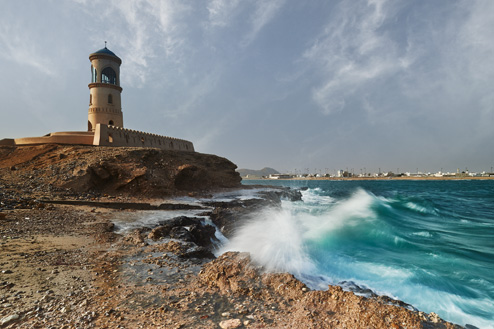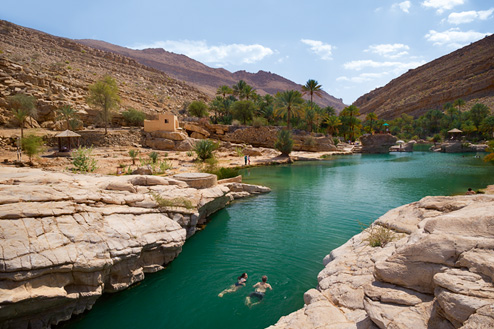Dhofar
Salalah
Salalah is the capital of Dhofar, the southernmost region of Oman, and is over 1,000 kilometres from Muscat. It is possible to get there by road, but the drive is long and boring, with little of interest to see or do along the way. You may therefore prefer to fly, and Oman Air operates up to five flights a day from Muscat.
The landscape features plenty of trees, mainly at the border of the desert at the lower reaches of the jebels. You’ll also find an impressive grouping of trees in Wadi Qahshan that runs through the mountainous backdrop of the Mughsayl-Sarfait road which links Salalah with the Yemen border. This is where frankincense trees grow and are farmed by local villagers. They cut into the trunks and allow the sap to seep out and harden into lumps that are then scraped off and traded in bulk.
Salalah has a museum, and the souks are worthy of a visit. Al Husn Souk is the place to head if you’re after silver jewellery or traditional souvenirs. It’s also an excellent place to pick up some fine Dhofar frankincense. At Al Hafah Souk, south of Salalah, you’ll find plenty of perfume and locally prepared food. Al Sinaw Souk is where Bedouin tribes used to conduct their business, and is famous for authentic Bedouin jewellery.
If you are camping and need to get supplies, you’ll find a branch of Lulu’s Hypermarket in Salalah, which offers a wide range of goods.
The restaurants and bars within Salalah’s hotels are your best bet for a night out. Both the Hilton and the Crowne Plaza have various outlets, which are popular with locals and tourists.
Out Of The City
Salalah is relatively small and, depending on the length of time you are there, you may wish to explore further afield. Wadi Darbat is within easy driving distance from Salalah, and features some great attractions. The Travertine Curtain, which looks like a huge pitted wall and is over 150m high, turns into a spectacular waterfall during the khareef as the entire contents of Wadi Darbat flow over this escarpment – it’s Arabia’s answer to Niagara Falls. There are several paths taking you towards the base of the cliff, with the going getting easier as you move past the trees towards the open grassland. Enjoy the spectacular views, and don’t forget the camera. On a safety note, there are no guard rails, and the edge drops off steeply, so keep children well back.
Wadi Darbat itself is misty, moody and muddy during the khareef, but in winter it is a verdant oasis. As you approach the wadi, just two kilometres from the Darbat turnoff, look out for the natural arch up to your right – this interesting feature can be reached with a short hike, and offers superb views over the surrounding valley, as well as a collection of small caves with stalactites and stalagmites. As inviting as it may seem, the water in Wadi Darbat is not for swimming in, due to the risk of picking up a bilharzia infection.
Khor Ruwi, which is near the coastline in the Wadi Darbat area, used to be a bustling seaport, although it’s hard to believe now. It is also home to an important archaeological site that was once the palace of the famed Queen of Sheba, and is where the waters of Wadi Darbat flow before finally reaching the ocean. The area is great for birdwatching, and flamingos are common from autumn to spring. From Khawr Ruwi you can hike up to the headlands above the eastern entrance to the lagoon – a large, flat plateau eventually leads to an abrupt edge with a 30m drop to the ocean.
Ubar
At the crossroads of ancient trade routes, the Lost City of Ubar (referred to as Iram in the Quran) thrived as merchants came from far and wide to buy much sought-after incense. Traders converged to sell pottery, spices and fabric from India and China in return for the unique silver frankincense of Oman. The commerce made Ubar a city of unrivalled wealth and splendour and those who visited it referred to it as ‘paradise’. According to the Quran, the wickedness of the inhabitants led Allah to destroy the city and all roads leading to it, causing it to sink into the sand. For a thousand years the city’s location remained unknown, until British explorer Sir Ranulph Fiennes, in a 20-year search using modern satellite technology, discovered the city beneath the shifting sands of the Omani desert near Shisr, north of Salalah. Excavations have revealed the thick outer walls of a vast octagonal fortress with eight towers or pillars at its corners, and numerous pots and artefacts dating back thousands of years. Debate continues as to whether this is indeed Ubar, but the site is fascinating nonetheless and it was clearly an important desert settlement at one point. Tours of the city will take you through the Qara Mountains where you can enjoy the stunning landscape.













